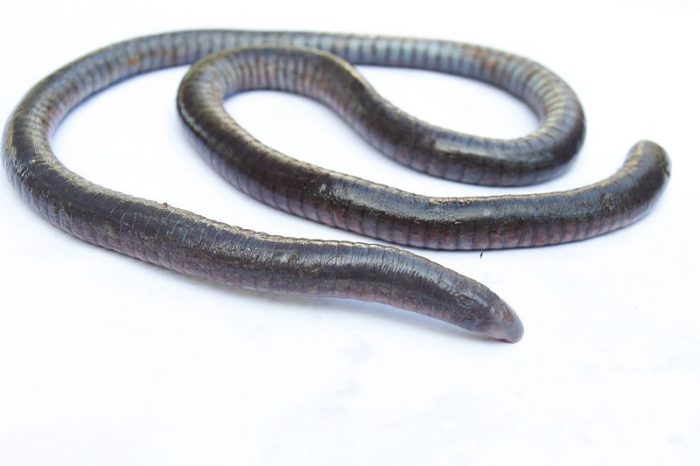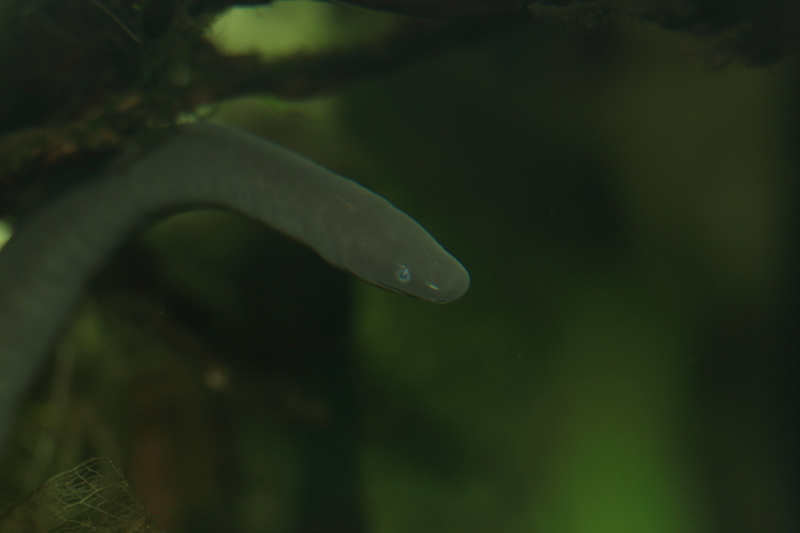In the animal kingdom, you've got your land animals, and your water animals, and your sky animals. Mammals and reptiles and fish and birds. Occasionally, these types of animals blur the lines—birds that swim, mammals that fly. But for the most part, they do their things in the places you'd expect them to.
Then there are amphibians.
Born like fish, growing up to live like reptiles, they are the great animal bridge between water and land—equally at home in both environments. And if you think that the way that frogs, toads, and salamanders live is curious, wait until you meet their cousins: caecilians (say suh-SIHL-yuhns).
These long, legless creatures look like a cross between snakes and worms, but they are neither. They are amphibians that live in tropical areas in South America, Africa, and Asia—certainly not anywhere in the United States or Canada.
Until now.
Found in Florida

Caecilians are nearly blind—their name means 'blind ones' in Latin. (Wikimedia Commons)
Scientists are blown away by the fact that a caecilian was found in a canal in southern Florida. The species—known as the Rio Cauca caecilian (Typhlonectes natans)—can reach around 50 cm (20 inches) in length. It is only known to live in freshwater areas in Colombia and Venezuela. Which makes ending up in Florida quite an impressive migratory journey. A little too impressive, perhaps.
There's only two ways to get to Florida from South America. Swimming a distance of nearly 2,000 miles across a huge stretch of saltwater ocean that caecilians would find toxic, or 'walking' (wiggling, crawling) all the way up Central America, into the United States, and across to southern Florida. Okay, maybe there are three ways.
Humans could've brought one there.
Probably a lost pet
This third option is the one that experts believe is most likely to explain the caecilian found in Florida. Rio Cauca caecilians, or 'rubber eels', are traded as pets among amphibian and fish enthusiasts, and they have been known to breed in captivity. Meaning that this fellow was likely an escaped pet (or related to one).
The next question is: Was this a one-time thing, or has a community of former pet caecilians been started in the wild?
An invasive species?
The hefty—and hungry—cane toad became a huge problem after being introduced to Australia, but it is unlikely that caecilians would ever affect Florida like that. (Getty Embed)
It is true that animals introduced into a new habitat (or invasive species) are a real phenomenon. In fact, one of the worst cases of this happening is the case of the cane toad in Australia. Introduced from Hawaii in 1935 to try and control the pest known as the sugar beetle, humans forgot to think about what local animals would eat cane toads, who protect themselves with toxic glands. The toad went on to dominate the landscape and become a far worst pest to local wildlife than the beetle ever was. Could this happen with caecilians?
The answer is almost certainly no. Caecilians aren't ferocious predators, nor are they poisonous to eat. And it would take a big breeding program to have them really take hold in Florida or any other new habitat. But that said, Florida's warm fresh waters are an ideal place for them and more of these reclusive creatures could absolutely be hiding there.
The search is on, we suppose!
 Native to South America, this animal has been found in Florida. How did it get there? (ID 83012855 © Lukas Blazek | Dreamstime.com)
Native to South America, this animal has been found in Florida. How did it get there? (ID 83012855 © Lukas Blazek | Dreamstime.com)










Cool 😎 😎 😎 😎 😎 😎 😎 😎
I found someone like this on my farm in TN. If not caecilians what could they have been. It was near a pond in a hole all this baby snakes